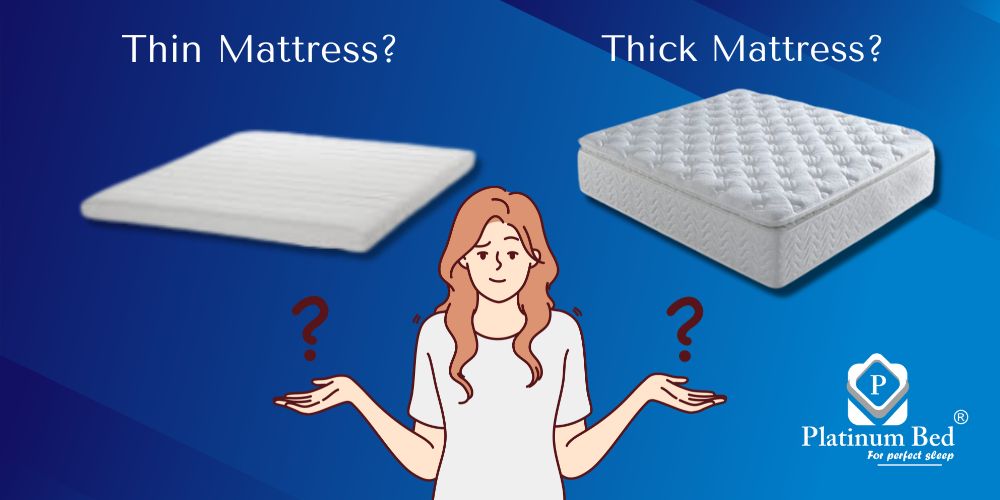How to Choose Right Mattress Thickness for Yourself?
Two significant factors that determine mattress thickness are the comfort layer and the support layer.
Comfort Layer: The comfort layer is the top layer of the mattress that provides immediate comfort and pressure relief. It is made of materials such as memory foam, latex, or pillow-top padding. The thickness of the comfort layer can vary based on personal preferences and the desired level of cushioning. Thicker comfort layers offer a more plush and contouring feel, while thinner layers provide a firmer surface.
Factors that influence the thickness of the comfort layer include the type and density of the materials used. For example, a memory foam mattress may have a thicker comfort layer to provide better body contouring and pressure relief, while a latex mattress might have a thinner comfort layer for a more responsive and supportive feel.
Support Layer: The support layer is the core of the mattress and is responsible for providing spinal alignment and support to the body. It often consists of coils (innerspring mattresses) or high-density foam (foam mattresses). The thickness of the support layer is crucial for maintaining proper spinal alignment and preventing sagging.
The thickness of the support layer is determined by factors such as the type of mattress and the targeted level of support. For example, innerspring mattresses may have thicker support layers with more coils for added support and durability, while foam mattresses may have thicker layers of high-density foam for optimal support and longevity.
It’s important to note that the ideal combination of comfort and support layers can vary based on individual preferences, body weight, and sleeping positions. Manufacturers consider these factors when designing mattresses with specific thicknesses to cater to different sleep needs.
Mattress Thickness Guide : What Mattress Thickness Do You Need ?
-
Body Weight
Take your body weight and size into account when selecting mattress thickness.
Body weight plays a significant role in determining the appropriate mattress thickness for an individual. Here’s a brief overview of how body weight influences the choice of mattress thickness:
When it comes to selecting the appropriate mattress thickness based on body weight, here are some general recommendations (mattress thickness in inches):

- Sleeping Positions:
Different sleeping positions have varying support and pressure relief needs. Side sleepers often benefit from thicker mattresses that provide ample cushioning to relieve pressure points, while back and stomach sleepers may prefer a thinner, firmer mattress that maintains proper spinal alignment. When considering the appropriate mattress thickness based on sleeping position, here are some general recommendations:
Side Sleepers: Side sleepers often benefit from mattresses with greater contouring and pressure relief to alleviate stress on the shoulders and hips. A medium to thick mattress (10-14 inches) can provide the necessary cushioning and support, allowing for proper alignment and reducing the risk of pressure points.
Back Sleepers: Back sleepers mostly require a balance of support and spinal alignment. A medium-thick mattress (8-12 inches) can offer sufficient support to maintain the natural curvature of the spine while ensuring a comfortable sleep surface.
Stomach Sleepers: Stomach sleepers generally need a firmer mattress to prevent excessive sinkage and maintain proper spinal alignment. A medium to thin mattress (8-10 inches thick mattress) with a firmer feel can provide the necessary support and help prevent lower back discomfort.
Combination Sleepers: Combination sleepers who switch between various sleeping positions may find a medium-thick mattress (10-12 inches thick mattress) to be a versatile choice. This thickness can offer a balance of support and pressure relief, accommodating different sleeping positions throughout the night.
- Sharing a Bed
When sharing a bed with a partner, it’s essential to consider both individuals’ body types and comfort preferences. Finding the right mattress thickness can contribute to a restful sleep experience. Generally, a medium-thick mattress, around 10-12 inches, tends to work well for most couples. This thickness offers a balanced combination of support and cushioning, accommodating different body weights and sleeping positions. It provides adequate support for heavier individuals while still offering contouring and pressure relief for lighter individuals. However, if there is a significant disparity in body weights or comfort preferences, customizable or dual-firmness mattresses can be ideal. These mattresses allow each partner to select their preferred firmness level on their side of the bed. This way, both individuals can enjoy personalised comfort and support. Additionally, consider a mattress with good motion isolation properties to minimise disturbances caused by one partner’s movements. Ultimately, open communication and trying out different options together are key to finding the ideal mattress thickness that ensures a peaceful and comfortable sleep for both individuals sharing the bed.
- Medical Conditions
When considering mattress thickness based on medical conditions, it’s important to prioritize comfort and support to address specific needs. For individuals with back pain, a medium-firm mattress with a thickness of 8-12 inches can be suitable. This provides a balance of support and cushioning to alleviate pressure on the back and maintain proper spinal alignment.
It’s important to consult with healthcare professionals or sleep specialists for personalised recommendations based on your specific medical condition. They can provide better advice to help you choose the appropriate mattress thickness that supports your health needs and improves your sleep quality.
- Frame Design and Weight Capacity
If you have a platform bed or a solid foundation with slats close together, you can opt for various mattress thicknesses depending on your comfort preferences. Thicker mattresses, around 10-14 inches, can provide a plush feel, while thinner mattresses, around 6-8 inches, offer a firmer sleeping surface.
When it comes to bunk beds or trundle beds, thinner mattresses are typically preferred due to the limited space between the bed frames. A mattress thickness of 6-8 inches is often recommended to ensure proper safety and functionality while providing adequate comfort.
Consider the weight capacity of your bed frame when choosing the mattress thickness. If you or your partner are on the heavier side, opting for a thicker mattress (10-14 inches) can provide better support and prevent premature wear or sagging.
- Bed Height Preferences
When considering mattress thickness based on total bed height preferences, it’s important to achieve a balance between aesthetics and comfort.
- Low Bed Height: If you prefer a low-profile bed with a modern or minimalist aesthetic, opting for a thinner mattress can help achieve the desired look. A mattress thickness of around 6-8 inches can provide adequate support while keeping the overall bed height relatively low.
- Standard Bed Height: For those who prefer a more traditional bed height, a medium-thick mattress ranging from 8-12 inches is generally suitable. This thickness offers a comfortable sleep surface while maintaining a standard bed height that is convenient for getting in and out of bed.

- High Bed Height: If you prefer a taller or more luxurious bed height, a thicker mattress can help achieve that desired look. Mattress thicknesses of 12-14 inches or more can contribute to a plush and elevated sleep surface, creating a visually appealing and inviting bed setup.
Pros of a thick mattress
- Enhanced Comfort: A thick mattress often provides a more cushioned and plush feel, offering increased comfort and pressure relief. It can contour to the body’s curves and provide a more luxurious sleeping surface.
- Adequate Support: Thick mattresses typically offer better support, especially for individuals with heavier body weights or those in need of extra support for their back and joints. The added thickness can help maintain proper spinal alignment and reduce the risk of discomfort or pain.
- Durability: Thicker mattresses tend to be more durable and resistant to sagging over time. The additional layers and materials used in their construction contribute to their longevity, making them a worthwhile investment.
- Improved Motion Isolation: A thick mattress can often provide better motion isolation, minimizing disturbances caused by the movements of a sleeping partner. This can lead to a more uninterrupted and peaceful sleep experience.
Cons of a thick mattress
Cost: Thick mattresses are generally more expensive compared to thinner ones due to the additional materials and construction required. They may be out of budget for some individuals or families.
Heat Retention: Thicker mattresses tend to retain more body heat, especially if they have multiple foam layers. This can be a disadvantage for people who tend to sleep hot or live in warmer climates.
Bulky and Difficult to Move: The thickness of a mattress can make it heavier and more challenging to move or manoeuvre, especially when it comes to rotating or flipping it for maintenance purposes. Limited Compatibility: Thick mattresses may not be compatible with certain bed frames or foundations that have weight or height limitations. It’s essential to consider the compatibility of a thick mattress with your existing bed setup.
Pros of a thin mattress
Affordability: Thin mattresses are generally more affordable compared to thicker options. They can be a cost-effective choice for those on a tight budget or looking for a temporary bedding solution.
Easy to Move: Thin mattresses are lightweight and easier to handle, making them convenient for transportation, rotation, or flipping. This can be particularly beneficial for individuals who frequently move or need to rearrange their sleeping arrangements.
Firm Support: Thin mattresses often provide a firmer sleeping surface, which can be beneficial for individuals who prefer or require a more supportive feel. Some people find firmer mattresses to be more comfortable and conducive to a better night’s sleep.
Compatibility: Thin mattresses tend to be compatible with a wider range of bed frames and foundations. They can easily fit into bunk beds, trundle beds, or other specialized bed designs that have height restrictions.
Cons of a thin mattress
Limited Cushioning and Comfort: Thin mattresses generally offer less cushioning and plushness compared to thicker options. They may lack the contouring and pressure-relieving properties that many people seek for a more comfortable sleep experience.
Less Motion Isolation: Thinner mattresses typically have less motion isolation, meaning that movements from a sleeping partner can be more easily felt. This can result in sleep disturbances and may not be ideal for couples or individuals who are sensitive to motion transfer.
Durability and Longevity: Thin mattresses may have a shorter lifespan and be more prone to sagging or developing indentations over time. The reduced amount of materials and layers can affect their durability, especially for individuals with higher body weights.
Limited Versatility: Thin mattresses may not be suitable for individuals with specific health conditions or those who require extra support or cushioning. They may not provide the same level of customization or options as thicker mattresses.
Here is a mattress size chart in both centimetres (cm) and inches (in):
Twin/Single:
Size in cm: 183 x 91 cm
Size in inches: 72″ x 36″
Twin XL:
Size in cm: 183 x 122 cm
Size in inches: 75″ x 48″
Full/Double:
Size in cm: 72 x 72 cm
Size in inches: 183″ x 183″
Queen:
Size in cm: 183 x 152 cm
Size in inches: 72″ x 60″
King:
Size in cm: 183 x 178 cm
Size in inches: 72″ x 70″
Please note that mattress sizes can vary slightly depending on the country or region. The dimensions mentioned above are commonly used, but it’s always best to double-check the specific measurements offered by the manufacturer or retailer when purchasing a mattress.
Mattresses come in various thicknesses, and each thickness serves different purposes and offers unique benefits. Here are some common mattress thicknesses and their primary uses:
2-5 inches (Low):
6-8 inches (Slim): These thinner mattresses are often used in bunk beds, trundle beds, and guest rooms. They are suitable for children, lightweight individuals, or those who prefer a firmer sleeping surface.
8-10 inches (Standard): This is a standard thickness range for mattresses. They provide a balance between comfort and support and are suitable for most sleepers, including back, side, and stomach sleepers.
10-12 inches (Standard): Mattresses within this thickness range offer additional cushioning and comfort. They are a popular choice for individuals seeking a medium-firm to plush sleep surface with enhanced pressure relief.
12-14 inches (Thick): These thicker mattresses are often considered luxury options. They provide ample cushioning, deep contouring, and enhanced support. They are well-suited for individuals with specific comfort preferences.
14+ inches (Deep): Extra-thick mattresses are designed for ultimate comfort and luxury. They often feature multiple layers of foam, pillow tops, or Euro tops for a plush and sumptuous sleep experience. These mattresses are ideal for individuals who prioritize a luxurious feel and have no restrictions on bed height.
It’s important to consider your personal preferences, body weight, sleeping position, and any specific needs when selecting the thickness of a mattress. Keep in mind that thicker mattresses generally offer more cushioning and contouring, while thinner mattresses provide a firmer feel. Ultimately, the right thickness will depend on your comfort preferences and the level of support your body requires for a restful night’s sleep.
FAQs
What is the best mattress thickness?
When selecting the ideal mattress thickness, several factors come into play. Generally, mattresses range from 8 to 14 inches in thickness, with some exceeding these measurements. For most individuals, a mattress thickness between 10 to 12 inches is often recommended as it strikes a balance between support and comfort.
Is it better to have a thicker mattress?
Whether a thicker mattress is better for you depends on your personal preferences and specific needs. Thicker mattresses offer several potential advantages. They tend to provide more cushioning and contouring, creating a plush and comfortable sleep surface. Thicker mattresses can also offer better support, particularly for individuals with heavier body weight or those who require extra support for their back or joints. The additional layers and materials in a thicker mattress can contribute to its durability, ensuring it maintains its shape and support over time. Ultimately, the choice between a thicker or thinner mattress should be based on your personal comfort preferences, support needs, and budget considerations.
Why are mattresses so thick nowadays?
Mattresses have become thicker in recent years due to several factors and evolving trends in the bedding industry. One of the primary reasons for the increase in mattress thickness is the focus on comfort and customization. Thicker mattresses allow for more layers and materials to be incorporated, resulting in enhanced cushioning, support, and pressure relief. With advancements in technology and materials, manufacturers can now create multi-layered mattresses that cater to specific sleep needs and preferences. Additionally, thicker mattresses are often associated with a luxurious feel and are favored by those seeking a plush and indulgent sleep experience. Finally, the thickness of a mattress should be chosen based on personal preferences, body type, and individual sleep needs.
Is an 8-inch memory foam mattress thick enough?
An 8-inch memory foam mattress can be considered thick enough for many individuals, but it ultimately depends on personal preferences and specific needs. Memory foam mattresses are known for their ability to contour to the body, providing excellent pressure relief and support. The suitability of an 8-inch memory foam mattress will depend on your specific comfort and support requirements.
How thick is a standard queen bed?
A standard queen bed typically measures approximately 60 inches in width and 80 inches in length. As for the thickness, it can vary depending on the type of mattress and personal preferences. The thickness of a standard queen mattress usually ranges between 8 to 12 inches. However, it’s important to note that mattress thickness can vary among manufacturers and specific models. It’s crucial to consider individual needs, body weight, sleeping positions, and any specific comfort requirements when selecting the ideal thickness for a standard queen bed mattress.
What is a Good Mattress Thickness?
Determining a good mattress thickness depends on individual preferences, body type, and specific needs. In general, a good mattress thickness ranges between 8 to 14 inches. This range offers a balance of comfort, support, and durability for most sleepers. A mattress in this thickness range typically includes multiple layers of foam, coils, or a combination of both, providing adequate cushioning and support. Thicker mattresses often provide better pressure relief, especially for side sleepers or individuals with joint pain, as they allow for deeper sinkage and better contouring. However, it’s essential to consider personal comfort preferences and any specific requirements.
What is the average mattress thickness?
The average mattress thickness can vary depending on the type of mattress and personal preferences. However, in general, the average mattress thickness falls in the range of 6 to 12 inches. This range is considered standard and caters to a wide range of sleepers. Mattresses in this thickness range typically consist of multiple layers of foam, coils, or a combination of both. It’s important to note that mattress thickness can vary among different brands and models, so it’s essential to consider individual needs, preferences, and any specific comfort or support requirements when selecting the right mattress thickness.

Recent Comments